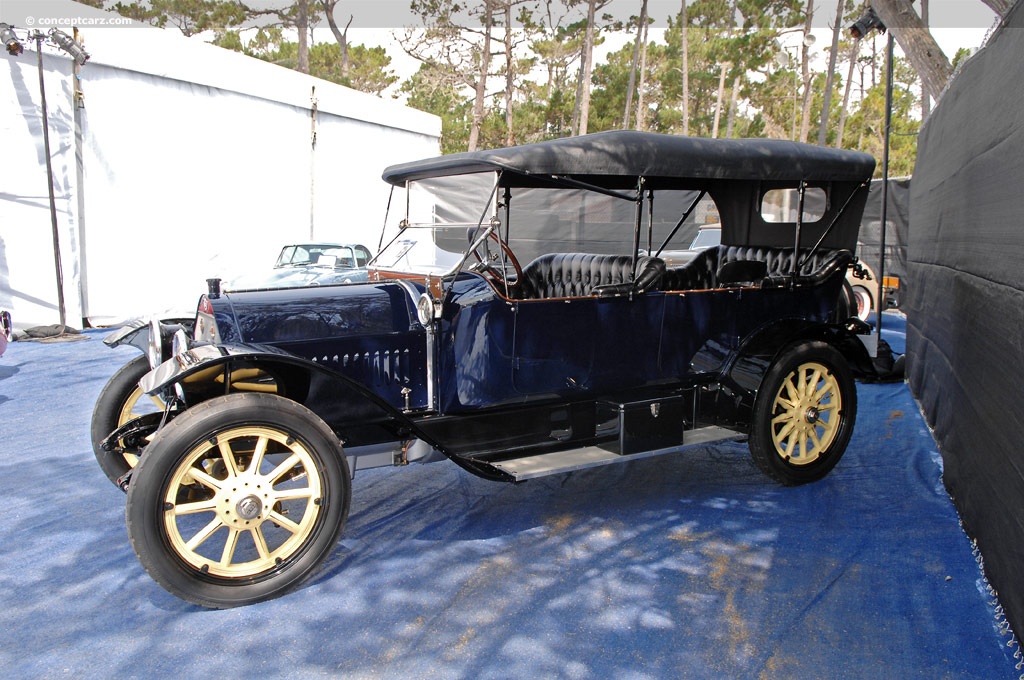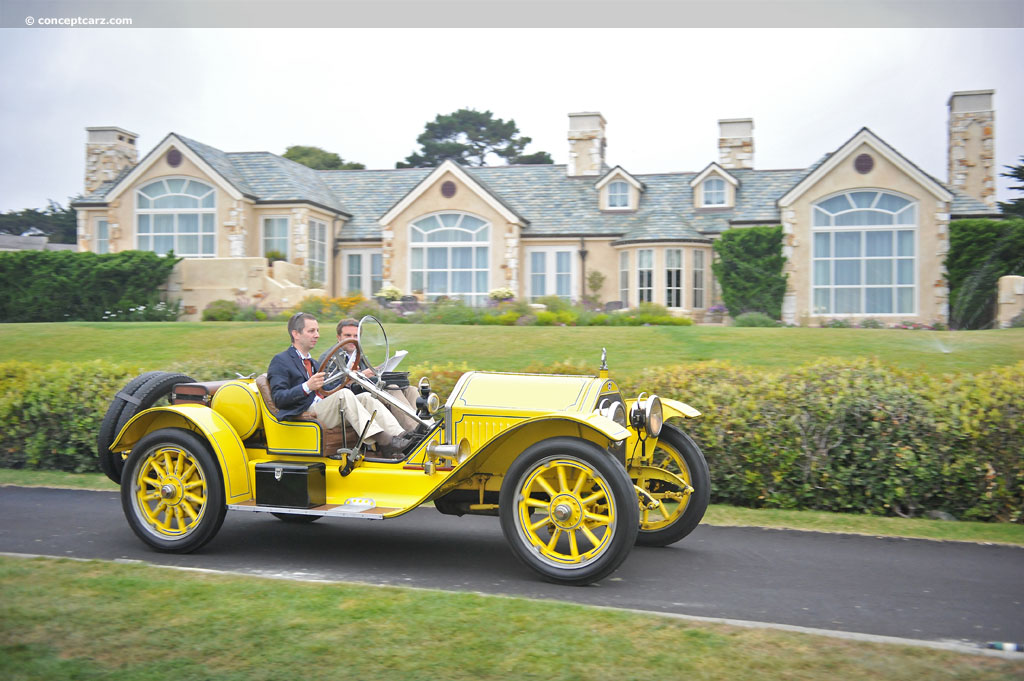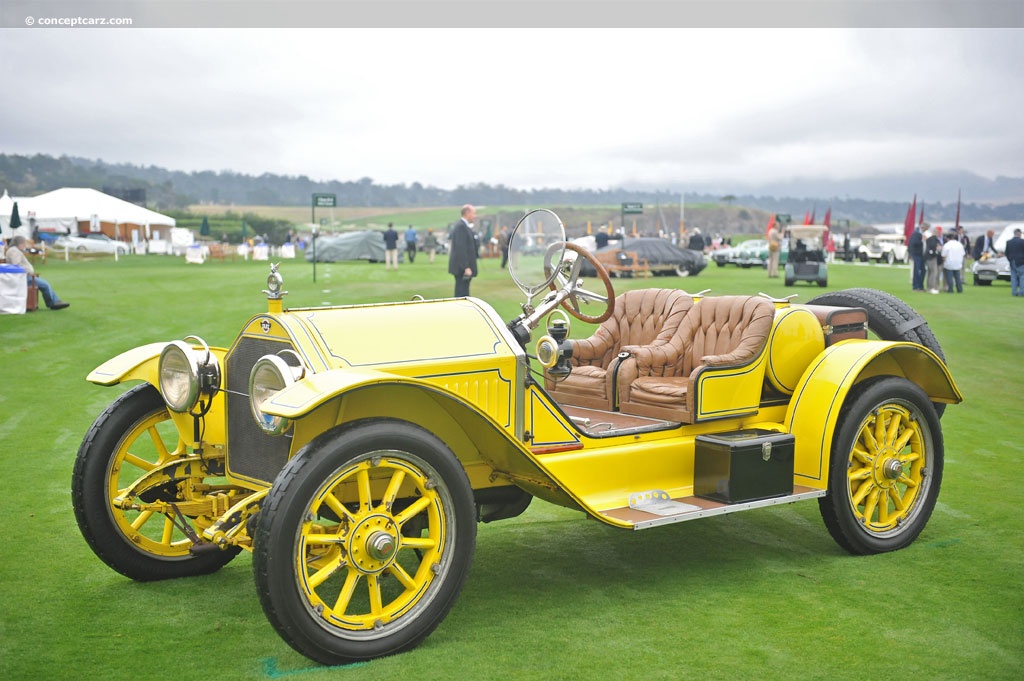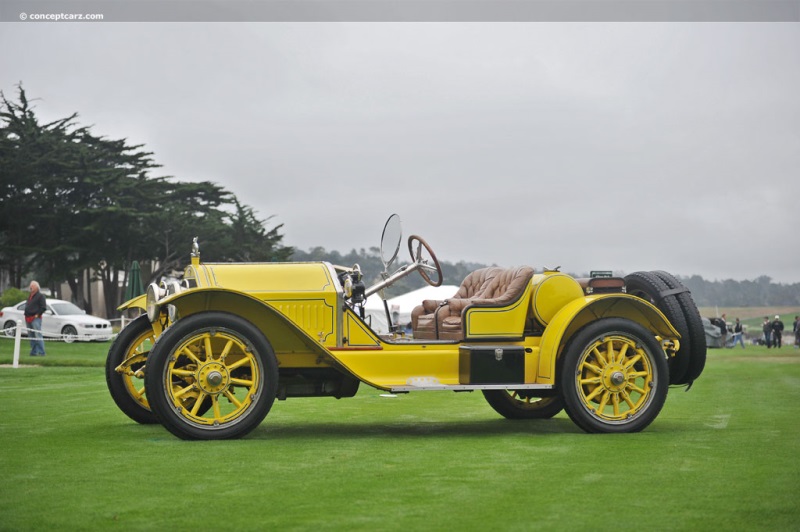Harry Clayton Stutz was one of the early American automobile industry's most skilled and colorful personalities who built his first horseless carriage, nicknamed 'Old Hickory,' in 1898 at age 22. He designed and built a single-cylinder engine in 1900 and later worked for various tire, auto parts, and carburetor companies before becoming chief engineer of the American Motor Car Company. The American Underslung models would gain fame during the pre-World War I era for their innovative 'underslung' chassis design. A year later, Harry Stutz joined the Marion Motor Car Company in Indianapolis, where he served as chief engineer and plant manager. Innovations he created during this time include the four-shoe-per-drum brakes and an innovative transaxle design. In 1908, the company was taken over by Willys, and Stutz left two years later.
Bearcat Roadster
Chassis #: 2177
Engine #: AI-609
View info and history
Auction entries : 1In less than five weeks, Stutz built an automobile that was entered under the name of his Stutz Auto Parts Co. at the inaugural Indianapolis 500 race in 1911, where it placed 11th overall with an average speed of 62.375 mph, earning it the slogan 'the car that made good in a day.' It received only minimal mechanical adjustment during the race, with 13 pit stops, 11 of which were for tires. The car had been completed just days prior to the start of the race, and despite suffering from tire trouble throughout the race, its ability to finish, let alone place as well as it did, proved the engineering capabilities and the quality of Harry Stutz. In June 1911, Stutz and his friend, Henry F. Campbell, organized the Ideal Motor Car Company of Indianapolis with the purpose of building copies of the racecar with added lights and fenders. The name of the Indy 500 racecar was called the Bear Cat, and the production model name was the Stutz Bearcat. Stutz improved its finishing position in the 1913 Indianapolis 500 to 3rd Place. The company's famous 'White Squadron' of racing cars roared from victory to victory in 1915, capturing wins at Elgin, Point Loma, and Sheepshead Bay while also finishing 3rd, 4th, and 7th at the 1915 Indianapolis 500.The production Bearcat was a stripped-down, minimalistic, two-seat sports car, the period sales literature boasted 'designed to meet the requirements of the customer desiring a car built along the general lines of a racing car and with a slightly higher gear ratio than our regular torpedo roadster.' It could be specified with either four- or six-cylinder engines (the 60 horsepower six was added to the range in 1912), however, the definitive version was equipped with the 389 cubic-inch four-cylinder T-head unit produced by the Wisconsin Motor Manufacturing Company of Milwaukee. The 6.4-liter Wisconsin four engine had a twin-camshaft 'T-head' design with inlet valves on one side of the block and exhausts on the other. It would be used up to 1917, when Stutz began to manufacture its own power units. Priced at $2,000, the Bearcat was equipped with a tool kit, three-speed transaxle, Warner speedometer, and Bosch ignition, and available in four colors of Vermilion, Monitor Grey, Mercedes Red, or Yellow.
Touring
Chassis #: 4E2018
Engine #: A1526
View info and history
Auction entries : 1Cannon Ball Baker added to the laurels of the Bearcat and further reinforced its reputation for durability in 1915 when he drove a stock example on a record-breaking cross-country run. At the time, the roads from the Midwest to the West Coast were virtually nonexistent, but Baker was relentless, eventually shattering the existing record and making the crossing in eleven days, even-and-a-half hours. During the trip, the total damage to the Bearcat amounted to one broken shock absorber clip. This extraordinary feat, along with others, led to the nickname, 'The Sturdy Stutz.'In 1912 Stutz won 25 out of 30 competitions entered, thanks to the Bearcat. The Stutz Bearcat quickly established a rivalry on the road and the track with the Mercer Raceabout. The Mercer was agile and lightweight, while the Stutz favored brute force and strength. Spectators knew the taunts of 'You gotta be nutz to drive a Stutz!' 'But it's worser to drive a Mercer!'Most automakers of the Brass Era were regional, but Stutz wanted to move into every market that he could, including the West Coast of California. Walter Brown, a dealer based out of Santa Monica who established a Los Angeles-based team of Stutzes in September 1911, was the sales agent of Stutzes west of the Mississippi. The high-powered, fast Stutz automobiles proved popular with the affluent California region and its many privateers. The growing number of Stutz dealerships and the race-proven credentials helped propel sales to over 1,000 units by 1915. 
Bearcat Roadster
Chassis #: 2177
Engine #: AI-609
View info and history
Auction entries : 1The Wisconsin T-head engine was eventually replaced by a Stutz-built, sixteen-valve, four-cylinder unit derived from Stutz's racing experience. The 'White Squadron' racers used versions with four valves per cylinder which quickly proved the performance potential over a traditional two-valve motor. In road-going guise, the 360 cubic-inch T-head 16-valve 4-cylinder unit with dual ignition breathed through a single Stromberg carburetor and delivered 88 horsepower. It was backed by a three-speed manual transmission and used a leaf spring suspension in the front and rear, with braking handled by rear drums. The new engine was installed in a new and more advanced chassis that was heavier to cope with the power as well as to accommodate modern coachwork. It continued to use a 120-inch wheelbase size but had the center of gravity lowered by placing the tank down low in the rear, with a rear deck fitted to hold a pair of raked spare tires in racing fashion. The Bearcat remained a fixture of the range until the end of the 1924 season when the installation of Frederick E Moskovics as company president marked a change of emphasis to the luxury end of the market.Without question, the Bearcat represented the ultimate in American sporting cars of the time and the man who built them proved that he was both equally brilliant at engineering and salesmanship. 1914 Stutz
The four-cylinder Stutz automobiles were known as the Series 4E, and those equipped with six-cylinder power were called the 6E. The Series 4E rested on a 120-inch wheelbase platform, while the Series 6E used a 130-inch wheelbase. The four-cylinder roadster was priced at $2,000, and the six-cylinder version was $250 higher. The five-passenger tourer Series 4E listed for $2,150 while the six-passenger Tourer SEries 6E listed for $2,400. The four-cylinder Bearcat sold for $2,000.
Bearcat Roadster
Chassis #: 2177
Engine #: AI-609
View info and history
Auction entries : 1Stutz produced 649 vehicles in 1914, slightly less than the 759 units built the previous year.
by Daniel Vaughan | Oct 2021

Bearcat Roadster
Chassis #: 2177
Engine #: AI-609
View info and history
Auction entries : 1

Touring
Chassis #: 4E2018
Engine #: A1526
View info and history
Auction entries : 1

Bearcat Roadster
Chassis #: 2177
Engine #: AI-609
View info and history
Auction entries : 1
The four-cylinder Stutz automobiles were known as the Series 4E, and those equipped with six-cylinder power were called the 6E. The Series 4E rested on a 120-inch wheelbase platform, while the Series 6E used a 130-inch wheelbase. The four-cylinder roadster was priced at $2,000, and the six-cylinder version was $250 higher. The five-passenger tourer Series 4E listed for $2,150 while the six-passenger Tourer SEries 6E listed for $2,400. The four-cylinder Bearcat sold for $2,000.

Bearcat Roadster
Chassis #: 2177
Engine #: AI-609
View info and history
Auction entries : 1
by Daniel Vaughan | Oct 2021
Related Reading : Stutz Bearcat History
The Stutz Bearcat was produced from 1914 through 1924. The first version was produced from 1914 to 1917 and was powered by a 6388 cc four-cylinder engine. The Bearcat was a creation inspired by an Indy sports car racer built by the Stutz Motor Company in 1911. It was powered by a 361 cubic-inch four-cylinder engine that produced 50 horsepower. The Bearcat continued the tradition of lightweight construction,....
Continue Reading >>
Continue Reading >>
Similar Vehicles
Similar Automakers
Similarly Sized Vehicles
from 1914
1914 Stutz Model 4E Vehicle Profiles
Recent Vehicle Additions
Related Automotive News

World Challenge America At Las Vegas Motor Speedway Presented By R.U.N. | October 17-20, 2019
Las Vegas Motor Speedway, Las Vegas, NV
Roval combination oval and road course featuring 9 turns
Race 1 Saturday, October 19, 2019 at 140 pm PST Race 2 Sunday, October 20, 2019 at 1230 pm PST
Watch Live httpswww.tcamerica.uslive
FAST...

Sportiness In The Brand DNA: Game-Changer With Mercedes-Benz At Goodwood Festival Of Speed 2017
With a dozen racing cars and sporty vehicles from over 100 years, Mercedes-Benz Classic sums up the motto of this years Goodwood Festival of Speed Peaks of Performance – Motorsports Game-Changers celebrates competition vehicles that have written...

NEW SCCA PRO FORMULA LITES SERIES ENJOYS SOLID MOMENTUM FOR INAUGURAL SEASON
(April 13, 2015) -- What began in 2014 as a worldwide launch at the automotive industrys largest tradeshow has now blossomed into one of motorsports true success stories as the new SCCA Pro Formula Lites series prepares for its inaugural season.
...
RRDC VOTES IN 37 NEW MEMBERS FOR 2013
HILLIARD, Ohio (Nov. 7, 2013) - Thirty-seven race-car drivers and motorsports professionals have been voted into the Road Racing Drivers Club in 2013. The group includes 13 Regular Members from the open-wheel and sports-car racing ranks, 20 Associate...

Firestone Returns As Presenting Sponsor of RRDC Evening With Brian Redman in Long Beach
The Firestone brand will return as presenting sponsor of the Road Racing Drivers Clubs fifth annual West Coast banquet honoring auto racings most influential leaders. This year, on Thursday, April 18, prior to the running of the Toyota Grand Prix of...








































